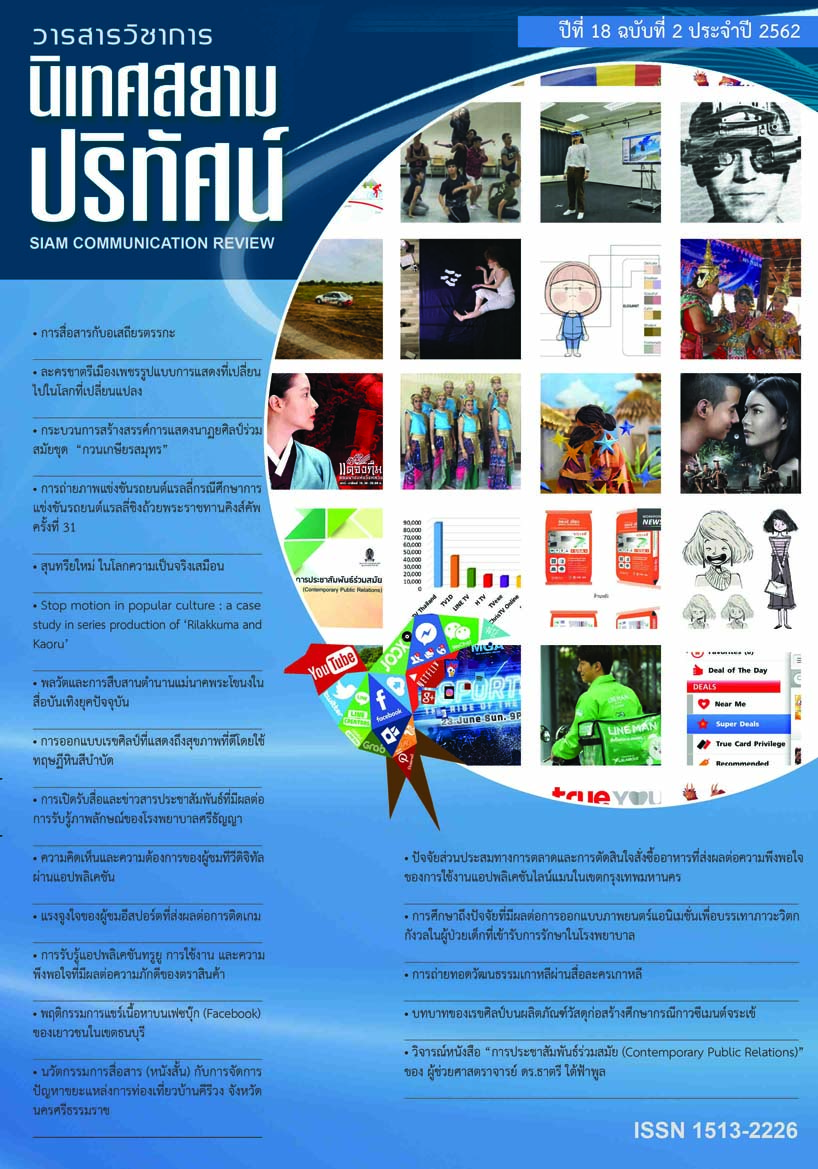The Dynamics and Preservation of the Legend of Mae NakPhrakhanong in Current Entertainment Media
Main Article Content
Abstract
“The Dynamics and Preservation of the Legend of Mae Nak Phrakhanong in current Entertainment Media” is qualitative research aiming to study the common and different features of various versions of the tale type Mae Nak Phrakhanong and to analyze how social and cultural contexts affect the reproduction and remake of the legend of Mae Nak Phrakhanong, using the performance-centered approach of folklore studies, the tale type-analysis approach and the functional approach of folklore studies. The research is based on the content study of three versions of the fictional media Mae Nak Phrakhanong, together with in-depth interviews of the scriptwriters of those versions.
It is found that the legend of Mae Nak Phrakhanong in current entertainment media from movies to plays and TV dramas is based on the same plot with different narratives, such as background framing, characterization, extension, reduction, and modification of the details according to the context in which it is presented as well as the collective memory of the people in society. The dynamics of the tales presented through communication process at different times and via different media are related to the social and cultural contexts in five aspects: the concept of ghost and feminism, the concept of ghost and monks, the concept of ghost and public health, the concept of ghost and military conscription, and the concept of ghost and otherness.
It is noted by the researcher that the reproduction and remake of the legend of Mae Nak Phrakhanong shows the collective memory reflecting the craving for justice which has been a chronic problem in Thai society so far.
Article Details
References
กำจร หลุยยะพงศ์ และสมสุข หินวิมาน. (2552). หลอน รัก สับสน ในหนังไทย. กรุงเทพฯ: ศยาม.
ธนากิต. (2539). 50 นิทานไทย. กรุงเทพฯ: สุวีริยาสาส์น.
บรรจง ปิสัญธนะกูล, สัมภาษณ์ 1 ธันวาคม 2561.
ปรมินท์ จารุวร. (2549). ความขัดแย้งและการประนีประนอมในตำนานปรัมปราไทย. กรุงเทพฯ: โครงการเผยแพร่ผลงานวิชาการ คณะอักษรศาสตร์ จุฬาลงกรณ์มหาวิทยาลัย.
พาณี ศรีวิภาต (2545). การศึกษาเปรียบเทียบวรรณกรรมเรื่อง “นางนากพระโขนง”. วิทยานิพนธ์มหาวิทยาลัยศิลปากร.
วรวรรณ ชัยสกุลสุรินทร์, สัมภาษณ์ 5 ธันวาคม 2561.
วัชราภรณ์ ดิษฐป้าน. (2549).แบบเรื่องนิทานสังข์ทอง: การแพร่กระจายและความหลากหลาย. กรุงเทพฯ: โครงการเผยแพร่ผลงานวิชาการ คณะอักษรศาสตร์ จุฬาลงกรณ์มหาวิทยาลัย.
วิชุดา ปานกลาง. (2539). การวิเคราะห์การถ่ายทอดความหมายเรื่อง “ผี” ในภาพยนตร์ไทยเรื่อง “แม่นาคพระโขนง” พ.ศ. 2521-2532. วิทยานิพนธ์นิเทศศาสตร์มหาบัณฑิต จุฬาลงกรณ์มหาวิทยาลัย.
ศิราพร ณ ถลาง, บรรณาธิการ. (2557). ไวยากรณ์ของนิทาน: การศึกษานิทานเชิงโครงสร้าง. กรุงเทพฯ: โครงการเผยแพร่ผลงานวิชาการ คณะอักษรศาสตร์ จุฬาลงกรณ์มหาวิทยาลัย.
ศิราพร ณ ถลาง และปรมินท์ จารุวร, บรรณาธิการ. (2560). อิงอดีต สนองปัจจุบัน: คติชนสร้างสรรค์ สังคม ร่วมสมัย. กรุงเทพฯ: โครงการเผยแพร่ผลงานวิชาการ คณะอักษรศาสตร์ จุฬาลงกรณ์มหาวิทยาลัย.
ศิริพร ไฝศิริ. (2544). การสร้างสรรค์ในการผลิตซ้ำภาพยนตร์ไทยจากตํานาน “แม่นาคพระโขนง”. วิทยานิพนธ์นิเทศศาสตรมหาบัณฑิต จุฬาลงกรณ์มหาวิทยาลัย.
สายป่าน ปุริวรรณชนะ. (2552). ตำนานประจำถิ่นริมแม่น้ำและชายฝั่งทะเลภาคกลาง: ความสามานฉันท์ใน ความหลากหลาย. กรุงเทพฯ: โครงการเผยแพร่ผลงานวิชาการ คณะอักษรศาสตร์ จุฬาลงกรณ์มหาวิทยาลัย.
สุภา จิตติวสุรัตน์. (2545). การสร้างความหมายทางสังคมและการรับรู้ “ความเป็นจริง” ในภาพยนตร์อิงเรื่องจริง. วิทยานิพนธ์นิเทศศาสตรมหาบัณฑิต จุฬาลงกรณ์มหาวิทยาลัย.
อิทธิพล วรานุศุภากุล. (2558). การเล่าเรื่องของ “พี่มากพระโขนง” และสัมพันธบทจาก “แม่นาคพระโขนง” สู่ “พี่มากพระโขนง”. วิทยานิพนธ์วิทยาลัยนวัตกรรมสื่อสารสังคม มหาวิทยาลัยศรีนครินทรวิโรฒ.
เอนก นาวิกมูล. (2549). เปิดตํานานแม่นาคพระโขนง. กรุงเทพฯ: มติชนปากเกร็ด.
ภาษาอังกฤษ
Erll, Astrid. Memory in Culture. Translated by Sara B.Young. London: Palgrave Macmillan, 2011.
Tim Wildschut and Constantine Sedikides. Nostalgia: Content, Triggers, Functions. Journal of Personality and Social Psychology Vol. 91, No. 5 (2006).


